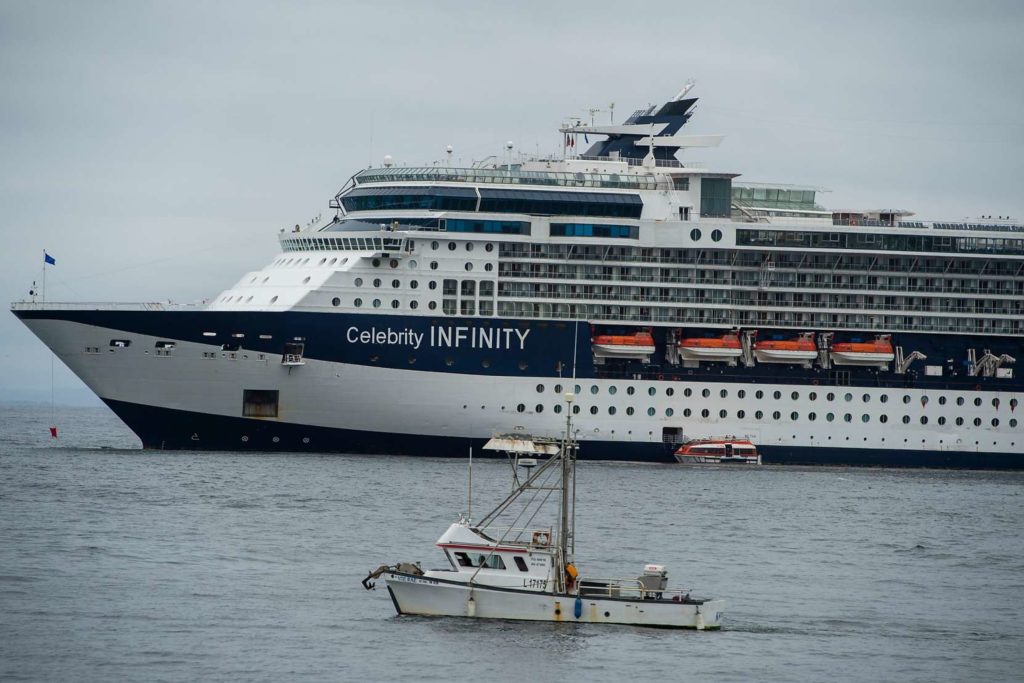Photo: Nic Coury
Should cruise ships be allowed in marine sanctuaries?
Originally published in The San Francisco Chronicle.
In October 2002, the cruise ship Crystal Harmony anchored outside Monterey Harbor, ferrying more than 900 passengers ashore for the day before continuing on its way to Acapulco, Mexico. Later that night, 14 miles off the pristine coastline of Big Sur, the 790-foot-long ship dumped 36,400 gallons of sewage, gray water and oily waste into the Monterey Bay National Marine Sanctuary.
Under federal law, cruise ships may release untreated sewage at least 3 nautical miles from land, and at the time federal laws didn’t prohibit discharges into the sanctuary, which extends 50 miles into the Pacific. But Crystal Cruises, the company responsible for Crystal Harmony, had signed a contract with Monterey agreeing not to discharge contaminated water into the sanctuary, and the dump was a clear transgression. The ship’s chief officer on watch the night of the incident “simply failed to remember that we were in the middle of a sanctuary,” Michael W. Coleman, a company spokesman, told the New York Times after the incident.
Monterey officials responded with conviction, issuing a 15-year ban on Crystal Cruises.
“We mean business and will do whatever it takes to protect our sanctuary,” said Carl Anderson, the city’s public facilities director, according to the Associated Press.
Fast-forward to this summer: Crystal Cruises will return to sanctuary waters for the first time in more than 15 years, with a visit to Monterey slated for Aug. 2.
Another highly scrutinized cruise company is visiting as well. Princess Cruises pleaded guilty in 2016 to seven felony charges “stemming from its deliberate pollution of the seas (between 2005 and 2013) and intentional acts to cover it up,” according to the U.S. Justice Department. Last year, a federal court ordered the company to pay a $40 million fine, the largest criminal penalty ever for intentional vessel pollution. This year, ships from Princess Cruises will anchor in the marine sanctuary for a total of six days — the most of any cruise line making stops in Monterey.
City officials say there’s little they can do — short of issuing an all-out ban on cruise liners — to prevent harmful practices of cruise ships, and they trumpet cruise visits as influxes of tourism cash. But some locals and environmental activists are alarmed by the prospect of exposing the sanctuary to industrial-scale pollution.
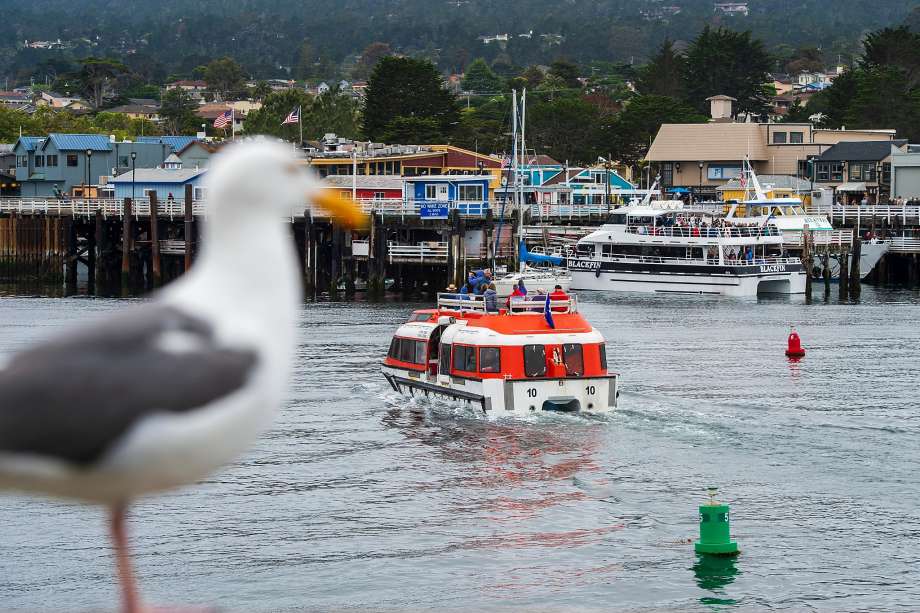
A tender boat shuttles passengers off the Celebrity Infinity cruise ship after it anchored in Monterey Harbor. Photo: Nic Coury.
“Letting a bunch of ships in that have bad track records, that just doesn’t make sense,” says Monterey resident Brent Allen, who operates a stand-up paddleboard tour business in the sanctuary. “If it were up to me, I would say cruise ships should not come in here at all.”
Relative to the thousands of cruise ship voyages worldwide each year, illegal discharges on record are relatively few and far between. However, concerns over the environmental impacts of cruise liners don’t end there.
Cruise ships exhale massive amounts of diesel emissions and incinerate garbage by the metric ton. Ships have also plowed into migrating whales, and they radiate noises underwater thought to harm marine life. What’s perhaps most concerning: No single governing body oversees the global cruise industry or monitors and enforces piecemeal regulations aimed at curbing pollution, and cruise companies aren’t always forthcoming about possible or blatant violations. Some of the worst violations on record weren’t discovered until months or years after they occurred.
Crystal Cruises didn’t immediately report the Crystal Harmony discharge, and it didn’t come to the public’s attention until months later, when the company filed paperwork with the California State Water Resources Control Board.
“I think (the discharge) was done by mistake … but there was clearly a cover-up,” says former Monterey Harbor Master Steve Scheiblauer, who was in office during the incident.
“The problem is not so much whether ships are violating standards, but that no one is looking to see if they are violating standards,” says Ross Klein, who runs CruiseJunkie.com, which tracks public reports of violations.
The 6,094-square-mile Monterey Bay marine sanctuary is the largest federally protected marine area in the U.S. and provides habitat for 34 species of marine mammals, including endangered blue and humpback whales. Californians may ask: Even if the risk of an incident is remote, how can we safeguard the integrity of our coast?
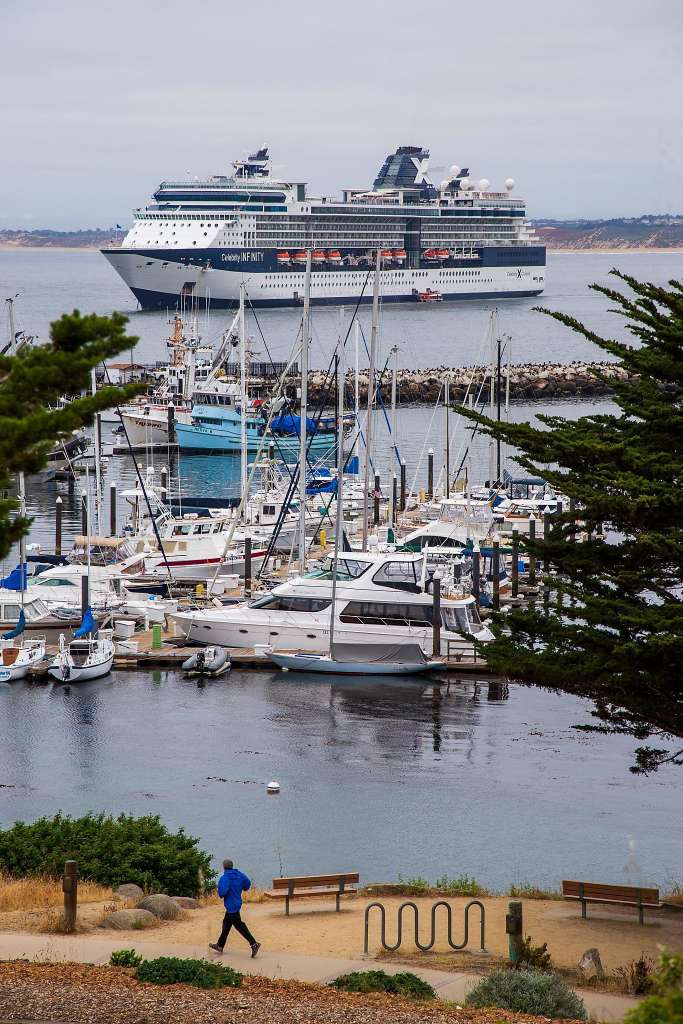
The Celebrity Infinity cruise ship anchored in Monterey on May 19, 2018. Photo: Nic Coury.
Modern cruise ships are essentially floating towns, complete with restaurants, bars, stores, dry cleaners, photo labs, medical clinics, and desalination and wastewater treatment plants. In one week, a typical cruise ship generates about 210,000 gallons of sewage, 1 million gallons of gray water, 25,000 gallons of oily bilge water and more than 7 tons of solid waste, according to a 2008 report from the National Oceanic and Atmospheric Administration (NOAA).
In the past 10 years, there have been 228 publicly reported pollution violations and fines issued worldwide, according to CruiseJunkie.com. The incidents range from inadvertent damage to coral reefs to brazen pollution. For example, two years ago, Carnival Corp. settled a legal dispute with Alaska over claims the company violated the state’s visible air pollution laws. In 2015, Brazil levied a $635,000 fine against MSC Cruises of Switzerland for dumping garbage bags overboard into the Atlantic Ocean two years earlier.
Regulating cruise liners presents obvious challenges: Almost all cruise companies are foreign-owned and -operated, and they travel through international waters.
At the U.S. federal level, the Clean Water Act and Act to Prevent Pollution From Ships stipulate that cruise liners must treat their waste and regulate their emissions. NOAA and the U.S. Coast Guard are primarily responsible for monitoring and enforcing those regulations. NOAA passed a rule in 2008 barring cruise ships from dumping anything except treated cooling water in sanctuaries around Monterey Bay, Point Reyes and the Farallon Islands.
NOAA and the Coast Guard also perform unannounced inspections of cruise ships in sanctuary waters. After dozens of inspections, Scott Kathey, NOAA regulatory/enforcement coordinator for the Monterey Bay National Marine Sanctuary, has encountered only one potential violation, which, he says, “appeared to be due to human oversight.”
State regulations vary — sometimes widely. Last month, after five years of public process, Washington state established a “No Discharge Zone” in the Puget Sound surrounding Seattle. (More than 90 such zones are in effect in the country.) But Oregon has no such regulations, and Gulf states are light on them, as is most of the Southeast, according to Marcie Keever, oceans and vessels program director for Friends of the Earth, an international network of environmental groups.
In 2004, in the wake of the Crystal Cruises dump, lawmakers in California, the country’s second largest cruise economy after Florida, passed laws banning cruise ships from dumping sewage within 3 miles of shore or incinerating waste within 20 miles of shore, extending the scope of federal rules already in place.
But environmental advocates say the current laws aren’t sufficient.
“Nationally and internationally, it’s a pretty low bar to meet regulations,” Keever says.
Friends of the Earth releases an annual Cruise Ship Report Card, and often gives failing and near-failing grades to major cruise lines for sewage treatment, air pollution reduction and water-quality compliance among their fleets.
In the past decade, the cruise ship industry has taken steps to improve its environmental practices. About 60 percent of the cruise ship fleet worldwide — including Princess and Crystal lines — has upgraded its sewage treatment devices, according to Friends of the Earth. Cruise Lines International Association (CLIA) requires member ships to treat sewage and wastewater before releasing it, and requires member companies to show that they have incorporated the association’s environmental policies into their own management plans.
Meanwhile, cruises are increasing in popularity. More than 27 million passengers are projected to take a cruise this year — up from 17.8 million in 2009, according to CLIA.
Cruise ship visits to Monterey ramped up after the 9/11 terrorist attacks, when Americans, worried about security at sea, wanted more domestic cruise options.
In 2002, three cruise ships anchored in Monterey; by 2003, the number spiked to 24 ships — the highest yearly number to date. This year, cruise ships are slated to make 11 visits to Monterey; 13 visits are scheduled for 2019. The larger vessels don’t stay overnight, and they’re allowed to anchor no more than 12 hours.
Monterey doesn’t solicit visits from cruise ships, city officials say. Cruise lines propose arrival plans, and the harbor master’s office responds — typically OKing a visit. Crystal Cruises is the only company that has ever been turned away.
When considering whether to readmit Crystal Cruises, Monterey Harbor Master John Haynes says he checked online and found that Crystal Cruises’ last violation occurred in 2009.
“After reviewing their recent track record, my staff and I made the call to allow Crystal Cruises back on the schedule,” Haynes says.
For its part, Crystal Cruises said in an email via a spokeswoman that it observes higher “environmental procedures and policies” than those required nationally and internationally.
“The company deeply regrets the incident” with Crystal Harmony, which it removed from its fleet in 2006, and “is pleased to be returning to the Monterey Bay region.”
The city is generally content to host cruise ships, local officials say: Liners anchor roughly a mile away from the pier and ferry passengers over on tender boats, injecting tourists by the thousands into the heart of the region.
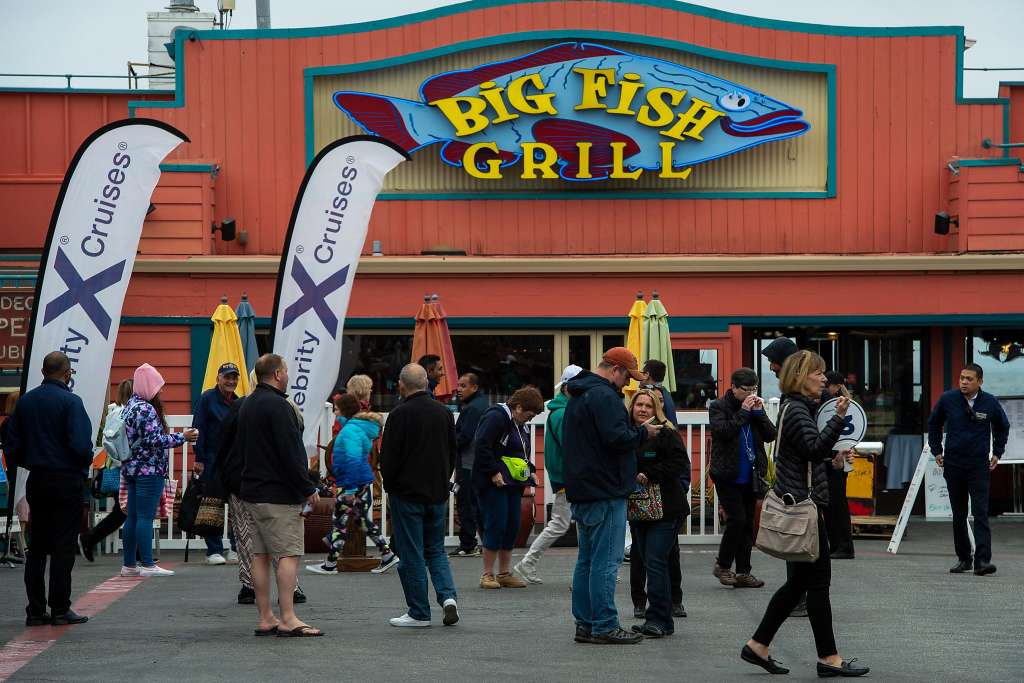
Passengers from the Celebrity Infinity cruise ship wander along Old Fisherman’s Wharf in Monterey. Photo: Nic Coury.
Cruise lines pay Monterey a “head tax” of $7 for each passenger who disembarks. Upward of 22,400 passengers brought in $156,856 in 2017, according to Haynes. The money has financed dock maintenance, restroom renovations, operation costs and advertising, he says.
Plus, each visitor spends about $134 per day at local businesses — they visit the aquarium, Cannery Row and the nearby historic district — according to Kim Bui-Burton, former community services director for Monterey. In October, the busiest month for cruise ships last year, 11,000 cruise passengers offloaded at Monterey Harbor. By Bui-Burton’s estimate, more than $1.4 million was spent.
Part of the enthusiasm over cruise ships stems from the idea that they boost the local economy “without burdening the city with up to 3,000 additional cars (and associated pollution),” Kathey wrote in an email.
They may not cause traffic jams but they pump out volumes of emissions, says Keever. Cruise ships can’t plug into dock power in Monterey, so they keep their engines running for the duration of their stays, producing nitrogen oxide, sulfur oxide, carbon dioxide and diesel emissions. To reduce these harmful emissions, the Environmental Protection Agency passed a rule in 2010 mandating that ships run on low-sulfur fuel within 200 nautical miles of the U.S. coast. (Emission data specific to cruise ships at anchor is not available.)
Another concern of large vessels in the sanctuary: the effects on marine life.
“At a minimum, the noise generated by large ships is incredibly harmful to marine mammals since so much of their communication is through sound,” Keever says. There have not been any comprehensive studies of noise effects on animals in the sanctuary.
Whale strikes are also a concern, though none has been recorded in the sanctuary. In 2011, a consortium of environmental groups, including Friends of the Earth, petitioned NOAA to enact regulations requiring large vessels to slow down when they enter California sanctuaries. NOAA declined, saying it didn’t have the resources to implement the rules, and would need to look more deeply into the issue.
Since 2002, all cruise lines that schedule port calls to Monterey have been required to sign a memorandum of understanding with the city that includes several environmental considerations and restrictions. But they aren’t enforceable. The city’s only recourse is to issue a ban.
When it comes to keeping a close eye on cruise ships in the marine sanctuary, the onus falls on the feds, says Monterey City Councilman Ed Smith, who previously served on the Monterey Bay National Marine Sanctuary Advisory Council.
“We’re basically a receiving station,” he says. “That doesn’t mean you turn a blind eye to (cruise ship issues), but we’re not the ones that do the oversight. … The city doesn’t own the bay.”
Keeping tabs on individual cruise ships seems to expose more violations.
For instance, in Alaska, where the Department of Environmental Conservation sends out Coast Guard-licensed Ocean Rangers to regularly inspect cruise ships, pollution events are recorded much more frequently than in other states. Between 2008 and 2014 alone, Alaska authorities issued 136 notices of violations to cruise ships pertaining to the state’s water-quality standards, according to CruiseJunkie.com.
“What you find when you actually pay attention is that there’s still a pollution problem,” even as ships update their treatment systems, Keever says. “So imagine what’s happening in a place with no monitoring that relies on out-of-date Clean Water standards.”
Monterey — and other coastal states and cities receiving cruise ships — have few options for safeguarding against this kind of pollution, Keever says. Asking the Coast Guard and NOAA to conduct more inspections of ships in the sanctuary would be a first step, she says. “It’s about making sure more eyes are watching.”
Another possibility is to marshal community support.
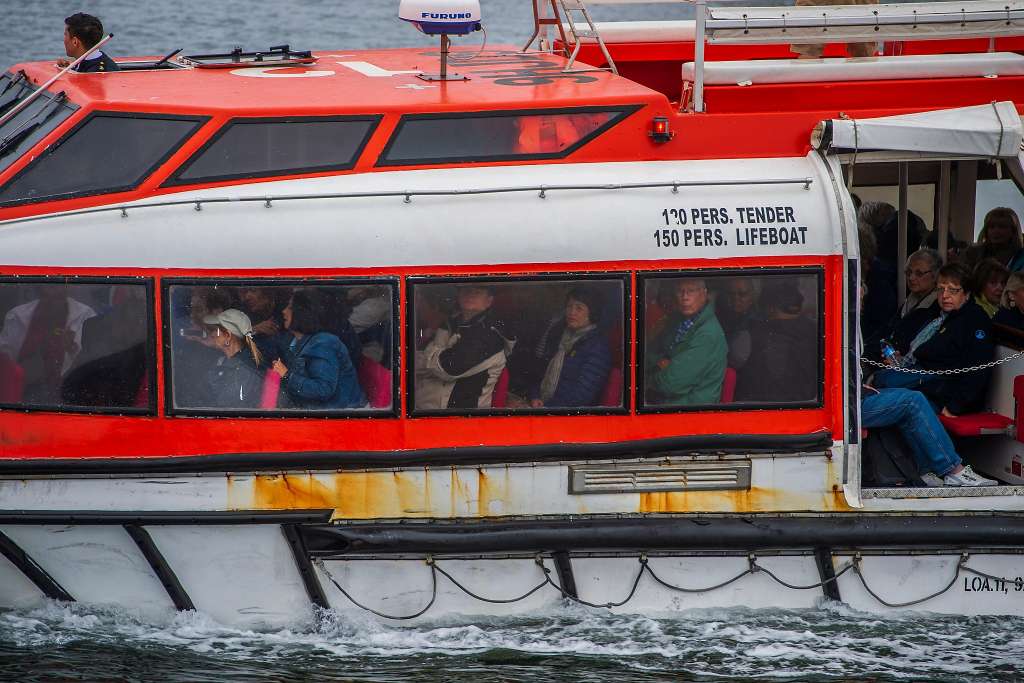
A tender boat carries passengers off the Celebrity Infinity, anchored in Monterey Harbor. Photo: Nic Coury.
In Santa Barbara, which received 20 cruise ship visits in 2017, the nonprofit group Santa Barbara Channelkeeper acts as “water watchdog,” sending out boats to patrol visiting cruise ships. It’s part of a broader international initiative on the part of Waterkeeper Alliance, a coalition of hundreds of groups that monitor 1.5 million square miles of water on six continents.
“We hail the captains over marine radio to remind them of their responsibility not to dump in our waters and let them know we’ll be watching them,” says Kira Redmond, executive director of Santa Barbara Channelkeeper. Though Channelkeeper does not have the resources to monitor every cruise ship, Redmond says they target the “worst performers” on the Friends of the Earth report cards.
Enforcing environmental accountability among leaders of a global industry is a monumental task. But Keever wonders whether there’s an appeal to be made to cruise lines that frequent places like Monterey, where nature is a main attraction.
“If they continue to pollute, they’re damaging their own business,” Keever says. “These are our waters. This is our air. This is why people come here in the first place.”
